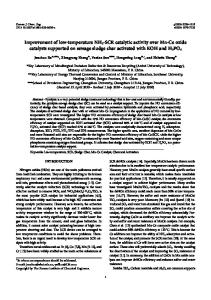A novel regeneration method for deactivated commercial NH 3 -SCR catalysts with promoted low-temperature activities
- PDF / 7,728,140 Bytes
- 17 Pages / 595.276 x 790.866 pts Page_size
- 36 Downloads / 317 Views
RESEARCH ARTICLE
A novel regeneration method for deactivated commercial NH3-SCR catalysts with promoted low-temperature activities Zheng Yan 1
&
Jingyao Yu 1 & Huan Liu 1 & Xin Ke 1 & Chunyong Wang 2 & Lili Liu 3 & Lihong Wei 1 & Tianhua Yang 1
Received: 23 January 2020 / Accepted: 9 July 2020 # Springer-Verlag GmbH Germany, part of Springer Nature 2020
Abstract A novel route is developed for regeneration of deactivated commercial NH3-SCR catalysts, which includes an initial in situ construction of anatase TiO2 porous film, followed by loading of MnOx, CeOx, and Mn-Ce mixed oxides as active components. The regenerated catalysts present largely improved low-temperature denitrification performance due to the synergetic effect of MnOx and CeOx. The denitrification efficiency could reach a high value of 97% at 200 °C and 100% at 250 °C when the Ce-Mn mixed oxides are loaded at the optimized molar quantity ratio of 10:9 (Ce:Mn). Properties and reaction mechanisms of the regenerated catalysts are investigated with characterizations of X-ray photoelectron spectroscopy (XPS), NH3 temperatureprogrammed desorption (NH3-TPD), H2 temperature-programmed reduction (H2-TPR), and in situ diffuse reflectance infrared Fourier transform spectroscopy (DRIFTS). Our results demonstrate that the adsorption and oxidation of NO plays a crucial role for these three catalysts even though a difference exists on the reaction pathways. Keywords Catalyst . Regeneration . SCR denitrification . Low temperature . TiO2 porous film . Mechanisms
Introduction Nitrogen oxides (NOx) are major atmospheric pollutants, which can cause great harm to human beings’ lives and natural
environment (Boningari and Smirniotis 2016). Selective catalytic reduction (SCR) technique has been demonstrated to be one of the most effective ways to control the emission of NOx (Damma et al. 2019; Lee et al. 2019). In order to achieve
Highlights • The deactivated commercial SCR catalysts was regenerated with in situ construction of anatase TiO2 porous film followed by loading MnOx and CeOx as active components. • The regenerated catalysts present largely improved SCR activities towards low temperature range (100–300 °C). • Satisfactory NO conversions can be achieved for the catalyst loaded with Mn-Ce mixed oxides compared with its analogue with the addition of MnOx or CeOx. • The reaction pathways are varied with different loaded active components. Responsible Editor: Santiago V. Luis * Zheng Yan [email protected]
2
College of Resources and Environment, University of Chinese Academy of Sciences, Beijing 101408, People’s Republic of China
3
Beijing Key Laboratory for Solid Waste Utilization and Management, College of Engineering, Peking University, Beijing 100871, People’s Republic of China
* Chunyong Wang [email protected] 1
Liaoning Key Laboratory of Clean Energy and Institute of Clean Energy and Environmental Engineering, College of Energy and Environment, Shenyang Aerospace University, Shenyang 110034, Liaoning, People’s Republic of China
Environ Sci
Data Loading...











